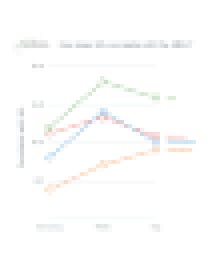Historically, students have been evaluated primarily on the basis of test scores and subject matter mastery. These factors remain relevant, of course. But now that we can better measure facets of SEL, how can we integrate data from students' social-emotional lives with data from their academic lives to better understand and support the whole child? More specifically, how is SEL associated with attendance, behavior and course performance (ABC)—and how do these associations vary across student demographics or educational contexts?
To answer these questions, Panorama Education analyzed data from more than 100,000 students at nearly 200 schools across the country. The data included traditional ABC metrics drawn from student information systems, as well as data from the Panorama Social-Emotional Learning Survey, which asks students to reflect on their behavior, attitudes and mindsets through psychometrically-validated, multiple-choice questions. Educators select which constructs to measure from a set of 23 SEL topics, including self-management, growth mindset and social awareness.
For the purpose of our research, we converted students' responses to integers, averaged the responses into grade-level-normed topic scores and averaged those topic scores into overall SEL scores. The results inform how we can integrate social-emotional and academic variables to better understand the whole child, create effective early warning systems and provide holistic student supports.
Our findings, shared below, echo those of social scientists whose evidence shows that how students think about themselves, each other and their learning is at the core of success in college, career and life. SEL matters, both as an end unto itself, as well as a means to increasing academic outcomes. A recent review of 87 intervention studies, for example, found that students exposed to SEL programming such as Second Step see a 13 percent advantage in academic performance over students who are not involved with SEL programming.
Here are three key findings from our research:
1. Social-emotional learning has significant, positive correlations with attendance, behavior and course performance.

At a high level, we see that all of the correlations are positive. Kids with higher SEL usually have better grades, assessment scores, behavior, and attendance. The SEL-GPA correlation is relatively large. Compared to kids who are low on several aspects of SEL, kids who are higher are twice as likely to have above-average grades.
If motivation, self-regulation, and social connection facilitate learning, we would expect these positive relationships.
2. The SEL-ABC correlations do not vary across other demographic variables.
We examined whether the correlations between social-emotional and traditional metrics vary significantly based on students’ race and ethnicity, gender and whether they were an English-language learner, qualified for free- or reduced-price lunch or received special education. In all cases, the ABC-SEL relationships did not depend on these student demographics.
This result is encouraging because it suggests that the relationships between social-emotional and traditional variables are not merely a product of demographics, but instead the result of actions and environments within educators’ control.
3. The SEL-ABC correlations depend on which social-emotional topics are being measured.
Finally, we examined how much these correlations depend on the particular SEL topics measured. In all cases, the correlations vary by SEL topic in revealing ways. Students’ attendance is more related to their sense of engagement and belonging than their growth mindset or grit; students’ grades are more related to their classroom effort and self-efficacy than their sense of belonging or safety; and students’ behavior in class is more related to their social awareness and self-management than their growth mindset or teacher’s academic expectations.
These findings don’t just reveal the validity of SEL measurement—they also reveal its value. By measuring students’ subjective experiences together with their objective performance and behavior, we get a foothold on which interventions work best and for whom. Correlation is not causation, but this pattern of results suggests how educators can better design SEL interventions to impact academic outcomes based on students’ grade-level and specific SEL competencies.
Recommendations for Taking Action on This Research
- Measure students’ SEL skills to understand students’ strengths and needs, and use the data to probe the potential root causes of academic, attendance or behavioral issues.
- Provide educators with real-time access to SEL and ABC data in a single platform. Educators at Ogden School District (UT), for example, use an early warning system that tracks student progress across SEL and the ABCs—helping them triangulate data from multiple sources to understand and address critical issues such as chronic absenteeism.
- Examine the correlations between SEL and the ABCs in your school or district to better understand opportunities for intervention. For example, if you suspect that concerns about safety or belonging are driving student absenteeism—and that by improving safety or belonging you can improve attendance—check your theory against the evidence.
These ABC-SEL relationships do not determine an individual student’s trajectory or what an educator can do to support a student at any given moment. Nor should they—education will always require the wisdom of experienced educators who know their students. But this sort of measurement can greatly inform educators’ efforts.
A student with high grades who feels disconnected from school requires different support—and perhaps even different teaching—than a student with high grades and a strong sense of belonging. And a school in which students’ behavior correlates highly with students’ social awareness may require different programming than a school in which disciplinary incidents are linked to poor teacher-student relationships.
Ultimately, by understanding how SEL relates to traditional metrics of achievement, behavior, and attendance, we can better set expectations, guide conversations, design instruction and fit interventions to students and schools.



